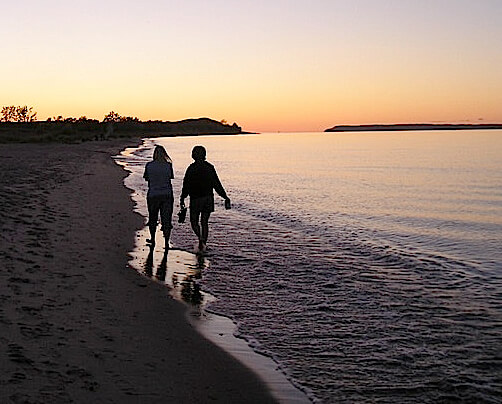25 Things You Can do To Improve and Maintain Water Quality
At our May 5 “Water and the Future of the Great Lakes” Speaker Series program, many who attended desired more info on what they could do as individuals to help protect and maintain Leelanau’s waters. Below is a list, based on resources from The Watershed Center, www.gtbay.org
1. Leave natural vegetation along the shoreline. Trees, shrubs, flowers, and intact native ground cover provide important habitat and reduce sediment and nutrient inputs.
2. Discharge boat bilge water completely upon take-out.
3. Empty recreational vehicle waste only at approved disposal locations.
4. Clean up pet waste within 50 feet of the shoreline and dispose of it in trash.
5. Do not feed waterfowl.
6. Plant native plants, which have longer roots to absorb more runoff and pollutants, reduce erosion, and decrease pesticides and maintenance. Learn more about native plant communities for our gardens and our wildlife at Go Beyond Beauty.
7. Don’t plant invasive plants. For more information about high-priority invasive plants and alternatives for wildlife habitat, healthy waters, and bountiful gardens in our region, visit Go Beyond Beauty.
8. Use rain garden and other examples of low-impact design to prevent stormwater runoff from residential areas. Keep rainfall onsite or infiltrate it into the groundwater. The next time you re-landscape your home, consider utilizing stormwater management practices that mimic and work with nature to eliminate runoff and promote groundwater recharge.
9. Property operate and maintain your septic system. Septics should be pumped every 2-4 years.
10. Keep stormwater away from your septic system and drinking water well. Excessive runoff can interfere with drainfield operation or seep down the well shaft and contaminate your drinking water.
11. Consider permeable surfaces in place of asphalt or concrete wherever possible.
12. Dispose of hazardous chemicals, automotive fluids, and other household waste properly: don’t dump them on the ground or down a storm drain.
13. Check with your local zoning administrator to see if there is a buffer ordinance. If so, use it as your guide; but remember, the deeper the buffer, the better for the lake.
14. Try to retain native vegetation along at least 75 percent of your shoreline length. The buffer should extend 35 to 50 feet deep from the water’s edge. Starting a buffer is usually as easy as not mowing the area.
15. If you would like to create views of the water, prune the branches of trees and shrubs, but do not cut them down. Remember, the roots of trees and shrubs protect water quality by reducing erosion.
16. Install areas such as rain gardens to store and treat runoff. Contour your property to direct runoff into low areas where it can collect temporarily and soak into the ground or where vegetation has an opportunity to absorb the water. Do not channel runoff directly into lakes.
17. Install temporary sediment control barriers before moving any soil. Immediately after you have disturbed the soil, seed the area, add sod or install plants and shrubs.
18. Remember to mulch, so loose particles will not be washed away during the first rain.
19. Do not pile leaves within 50 feet of the shoreline. Decaying organic matter adds excess nutrients to the water and depletes it of oxygen. Leaves kill beneficial vegetation.
20. If you have a wet shoreline where you would like to walk, consider building a floating boardwalk. This will allow you to walk across swales that have standing water or muddy vegetated areas. To reduce impact on vegetation, consider sharing a boardwalk with neighbors.
21. Plant a greenbelt garden between your lawn and the water to complement natural vegetation.
22. Leave grass clippings on your lawn to help retain moisture and provide vital nutrients for the soil. Allow grass height to be 2 1⁄2 to 3 inches high. This allows greener, healthier growth and reduces the need for fertilizer.
23. If you use lawn fertilizer: Have your soil tested to see if it even needs fertilizer. The Michigan State University Extension office in Bellaire conducts inexpensive soil testing and fertilizer recommendations. Select a phosphorous-free fertilizer. Excess nutrients such as phosphorus is one of the biggest threats to Grand Traverse Bay. Fertilizers containing even small amounts of phosphorous causes harmful algae growth that degrades water quality. Use the smallest amount necessary. Do not apply fertilizer right before it rains, as it will wash into the water.
24. Plant a fescue mixture rather than bluegrass when establishing a new lawn. Fescue requires much less nitrogen than bluegrass and is better suited to northern Michigan weather. Always choose a locally adapted grass. Consult local nursery experts.
25. If you are making plans to develop a new area or renovate an existing site, consider using Low Impact Development: a set of small-scale stormwater management practices that mimic and work with nature to reduce water runoff and pollutants. LID methods manage water and pollutants at the source, minimizing the impact of development on ground-water, streams, rivers, lakes and coastal waters. Please visit The Watershed Center website for more information.
Watch the video of our program: Water and Future of the Great Lakes




